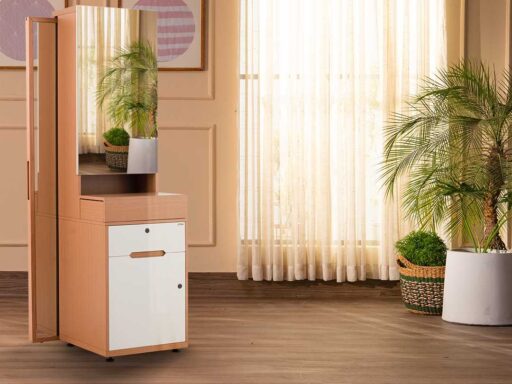Getting a good night’s sleep is among the most important things you can do to keep your health and well-being in check. To achieve this, however, you need to choose the right mattress. The type of mattress you have will make all the difference when it comes to having restful or restless sleep.
Unfortunately, there are so many mattress options in the market that it can get overwhelming. Especially when you need to choose between purchasing foam and spring mattresses. This is because each of them has a specific set of pros and cons. So, choosing the right one mainly depends on your sleeping habits, comfort preferences, and physical needs. As a result, in this blog, we will break down everything you need to know to make an informed choice.
What Is a Foam and Spring Mattress?
Foam mattresses are made completely with different types of foam. They generally have several layers and do not have any coils. These layers together wrap around your body and absorb any kind of movement.
On the other hand, spring mattresses use coils as the main support system of their structure. Throughout the years, spring technology has improved, so now they are often bouncier and offer better airflow. This makes them cooler than foam beds.
Foam vs Spring: Head-to-Head Comparison
Now, let us take a closer look at these two types of mattress and see how their features compare next to one another. The price of mattress in Bangladesh varies greatly due to the presence and absence of these features. Some of them are:
1. Comfort and Support
In terms of comfort and support, foam mattresses are great. They conform to your body by evenly distributing your weight and relieving the pressure points. So, these mattresses create a sensation of being hugged, which can be very comforting.
In comparison, spring mattresses offer more traditional features like a solid and firm surface. Due to this, they offer greater pushback as well as support. They help in maintaining spinal alignment, which is particularly crucial for people with back issues.
2. Durability and Lifespan
For foam mattresses, the durability depends on the foam type. High-density memory foam and latex are usually more durable. They are resistant to sagging and last more than a decade if properly taken care of. However, lower-density foams will get worn down sooner.
Spring mattress’s durability, on the other hand, depends on their material quality and construction. There are budget models with Bonnell or continuous coils that will start to sag within 5 to 6 years. However, pocket coil models will last around 8 to 10 years if it is maintained properly.
3. Temperature Regulation
In terms of temperature regulation, foam mattresses retain more body heat. Due to this, you have a higher chance of feeling warm during the night. On the other hand, spring mattresses, their coil-based design allows for better air circulation within the mattress. Due to this, they stay cooler compared to most foam models. As a result, spring mattresses are more popular for hot sleepers.
Who Should Choose a Foam Mattress?
Foam mattresses are mostly ideal for people who are side sleepers. They provide excellent pressure relief for the shoulders and hips. They are great for people with joint pain also, as their conforming nature reduces aches. Lastly, they are the best choice for bed sharers, like couples, as they will minimize motion transfer. This means there would be fewer sleep disruptions.
Who Should Choose a Spring Mattress?
On the contrary, spring mattresses are a great option for people who sleep on their backs and stomachs. This is because, with spring mattresses, you will get firmer support, which will maintain your spinal alignment. They are also ideal for hot sleepers, as spring mattresses have better airflow. This will keep you cooler at night. You can also opt for spring mattresses if you prefer some bounce and ease in moving around the bed.
How to Decide What Is Right for You?
So, if you are still not sure which type of mattress is right for you, here are some quick tips that can help you decide between the two:
Sleeping Position
- Side sleepers should go for foam or hybrid mattresses that offer pressure relief around the hips and shoulders
- Back sleepers should opt for spring or hybrid mattresses that support spinal alignments without sagging
- Stomach sleepers should go for a firmer spring mattress to prevent their hips from sinking too deep and keep their spine supported
Body Weight
- Lightweight sleepers should choose a softer foam mattress that will provide them with adequate support and comfort
- Individuals that are more on the heavy side need firmer mattresses. So, they should go for either a spring or high-density foam mattress. This will promote proper support over time
Conclusion
All in all, foam and spring mattresses have advantages and disadvantages. So, to make the right choice, you must focus on yourself and your preferences. If you are looking for pressure relief, quiet sleep, and a soft feel, then you should buy a foam mattress. However, if you like a firm support with better airflow, then a spring mattress is the right way to go.
So, take your time to assess your sleeping habits, budget, and physical needs before you jump into investing in a mattress.
FAQs
Do foam mattresses sag over time?
Yes. Foam mattresses, particularly low-density foam, sag over time. However, high-density and latex foams tend to be more durable. So they resist sagging much better.
How long should I keep my mattress?
Typically, most mattresses last between 7 to 10 years. However, their durability depends on the material of the mattress as well as how well they are maintained. The higher the quality, the longer they will last naturally.
Which mattress is better for back pain?
Foam mattresses, particularly memory foam or latex, offer better pressure relief and spinal alignment. However, a supportive spring mattress greatly helps in reducing back pain.





